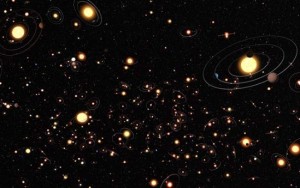Even in the most modern, mass produced storage media, it normally takes near a million atoms to store one bit of information. Big Blue hopes to reduce that a tad:
Now, researchers at IBM have teamed up with collaborators in Germany and Switzerland to store information using a related phenomenon, antiferromagnetism. And they’ve shown that it’s possible to store a bit in a feature that contains as few as six iron atoms. The downside is that the storage was only stable at extremely low temperatures. If the sample was allowed to heat up to 5K, the information on the bits vanished.
Five degrees Kelvin isn’t easy to reach, it’s really cold, only about two degrees warmer than intergalactic space. But technology has a way of moving on, and besides, we may not always be stranded here on earth. Space is vast. There’s a lot of room, for a lot of hard drive.
- Thanks in part to the Kepler mission, astronomers now reason there are more planets than stars in the Milky Way, putting the number of planets over 100 billion. A newly discovered exo-solar system suggests as much as half of them could be earth-sized and circle red dwarf stars, and a surprising number of these alien worlds may have two or more suns.
- The largest vertebrate known is the Blue Whale, the largest animals ever known to walk on land come from the Titanasaur branch of sauropod dinos, that’s old news. But the new record holder for smallest veterbrate could literally turn on a dime.
- A new poll of evangelical protestant pastors contains some sobering numbers:
[They] overwhelmingly believe that God did not use evolution to create humans …The survey of 1,000 American Protestant pastors, released Jan. 9, also found that ministers are almost evenly split on whether the earth is thousands of years old.
- In stark irony to the pastor poll above, the Hubble Space Telescope looks a whopping 13 billion years back in time, and captures this spectacular deep time shot of the first known generation of stars and galaxies to shine in an infant universe.


Leave a Reply
You must be logged in to post a comment.